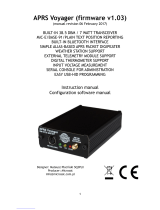Page is loading ...

TWIG Beacon is an indoor lone worker alarms solution
Manufacturer:
Twig Com Ltd.
24910 SALO, Finland
www.twigcom.com
Publication number: YZ3415-13-EN
All rights reserved. © Twig Com Ltd.
Due to dierences in use, installation and hardware, all settings and
functions may not be applicable to each device version.
RADIO FREQUENCY (RF) ENERGY
Transmission frequencies and power for TST90EU device types in EU are
listed in the table below.
Transmitter TX frequency bands
/ MHz
Max power / dBm
SRD 869.675 4
For any further questions please contact Twig Com support at support@
twigcom.com or +358 40 510 5058.
1. INSTALLATION OF BEACONS
TWIG Beacon has integrated lithium primary battery giving typical 3-4
year operating time. The operating time can vary according to use and
environment.
Mount the beacon to a suitable place based on desired radius for operation.
There’s a separate instruction leaflet for antenna pattern and directional
antenna adjusting. Mounting of the beacon should not be done against
metal wall or behind other metal materials as they are damping the signal
and can even totally block them in certain directions.
If the beacon must be installed to metal wall, there should be used 25 mm
thick non-metal spacer between beacon and the wall or install the beacon
sideways. If the beacon has antenna 90-degrees tilted or has separate wire
antenna it can be mounted directly to metal. However metal will damp
signal towards back direction.
Device must be installed vertically like in the picture. Note! The battery
direction should not be positive pole downwards in any installation because
it will damage the battery.
Once the beacon is mounted to a desired position it can be turned on
by inserting the jumper. Once the jumper is connected, the beacon is
operational. The LED will blink on transmission interval in green colour. If
the beacon is in configuration mode it will blink in 2 seconds interval in red
and green colours. When red led light is blinking, it is time to change the
battery.
2. INSTALLING SOFTWARE AND DRIVERS
Connect TWIG Beacon wireless configuration adapter to your computer’s
USB port. Allow Windows to install drivers automatically.
Once drivers are loaded, run the program TWIG Beacon Configurator.
Program will show each TWIG Beacon it can currently hear. Note that the
location of the beacon configuration box containing similar transceiver as
beacon, has significant eect. Do not place it on metal tables or close to
metal shelves.
3. DATA FIELD DESCRIPTIONS
The order of the listed beacon devices can be adjusted by clicking the given
name in the name field.
No = Position number to indicate how many beacons are ”visible” to the
configuration program.
TWIG Beacon
Quick Guide
Name= ID programmed to the unit. If no name is programmed the field will
be empty. Maximal length is 8 characters.
Interval is the programmed transmitting interval. Default value is 4 seconds.
The interval is only shown in programming mode. Changing interval longer
preserves battery but may result in loss of signal noticed by Protector in
some cases.
Tx Level = The level of transmission programmed to the beacon. Default
value is -20dBm
Rssi = The level of transmission the Configuration unit and also Protector
can hear the beacon.
Packet Count = Number of received data packages
Rec = Data reception is displayed with plus (+) sign. (The minus (-) sign can
be ignored).
When the beacon is in the configuration mode, the editor (see the picture
below) pops up by clicking the beacon on the list.

When the “Keep on config mode” box is ticked, all beacons in configuration
mode (marked in bold on the list) remain in the configuration mode 10
minutes also when outside the configurator coverage area.
When “Keep on config mode” box is not ticked, all beacons in configuration
mode (marked in bold on the list) will remain in configuration mode for 10
minutes from start or last configuration.
If the device is not configured during the given time, the beacon must be
restarted with the jumper in the main PCB.
4. PROTOCOLS & MESSAGING
TWIG Beacon transfers its data via ISM band. The relevant data is being
transferred to system backend via MPTP messaging. Please refer to TWIG
MPTP v3.24 or later for details.
5. SAFETY & RECYCLING
Usage: -20°C to +50°C
Storage: -30°C to +70°C
Do not open the device or battery by yourself or pierce holes in it. Rough
handling may break the circuitry inside the device. Do not drop, knock,
twist or shake the device or its battery. Keep the device dry, liquids contain
minerals which could corrode electronic circuits. If the device gets wet, turn
it o and dry the device and the battery immediately. Put the device into an
upright position and let it dry. It is recommended that a dealer or service
personnel check that the device functions properly. Even though the device
is waterproof, do not wet the device unnecessarily or immerse it in water.
Protect the device from heat. High temperatures may shorten the life of
the electronical devices, melt or warp plastics and damage batteries. Do
not warm up the device or battery or use it near fire. Do not short-circuit
the battery or battery contacts. Exposing the metal strips of the battery
to a close contact with a metallic object, such as a coin, a clip or a set of
keys can cause accidental short-circuiting and damage the battery. Use
the battery only for the purpose it is intended. Clean the device with a soft
cloth, dampened slightly with mild soapy water. Do not clean the device
with harsh chemicals, solvents or other corrosive substances. Only allow
service personnel authorised by the dealer to service the device. Recycle
the batteries according to the country-specific regulations.
/


